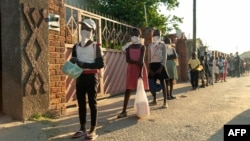The World Food Program (WFP) says hunger in Zimbabwe’s urban areas has increased over the past year with 2.4 million people now struggling to meet basic food needs.
According to the Zimbabwe Vulnerability Assessment Committee (ZimVAC) report coordinated by the Food and Nutrition Council, COVID-19 lockdowns imposed to contain the spread of COVID-19, have dealt a severe blow to poor urban communities, many of whom were daily wage earners living hand to mouth.
While unable to find work in cities, the WFP says, the ban on travel has meant that seasonal employment in rural areas is no longer an option.
With work opportunities disappearing, the recent report states that 42% of urban households will not be able to meet their cereal requirements this year compared to approximately 30% for the same period in 2019.
The World Food Programme (WFP) Representative and Country director, Francesca Erdelmann, said, “Reduced access to nutritious food has resulted in negative impacts for many. Families will find it difficult to put food on the table, most of them have been stuck at home and were not able to go to work, the fortunate ones will skip meals while those without will have to go to bed with an empty stomachs. For the most vulnerable people, hunger will have a lasting effect on their lives. The deteriorating hunger situation, caused by COVID19 threatens to be their biggest challenge.”
There has been a sharp decline in the standard of living across poor urban communities in Zimbabwe with 83% of urban households now below the cost of the minimum expected food items such as mealie-meal, salt and cooking oil compared to 76.8% in 2019.
One of the challenges faced by the urban households were sharp price increases of basic commodities while the purchasing power of the Zimbabwe dollar has been eroded by inflation and negative economic effects of COVID-19.
WFP’s urban assistance programme delivers monthly cash transfers to 326,000 Zimbabweans across 23 urban areas and depending on availability of resources aims to scale up to reach 550,000 people living in the 28 worst affected and food insecure urban areas in the country. Households are given cash through electronic transfers and vouchers that enable them to buy food items from selected retailers.
These include supporting urban agriculture such as mushroom and vegetable farming, building market linkages between rural-urban food value chains, setting up savings and lending groups and entrepreneurship training to support the establishment of small businesses.
WFP is working closely with the Government of Zimbabwe, UN agencies and NGO partners to implement the Urban Social Assistance and Resilience Building Programme and engaging with them on the development of longer-term shock-responsive social protection programme in urban areas.
WFP is able to deliver its Urban Social Assistance programme thanks to support from the UK, USA, ECHO, UN CERF, Switzerland, Canada, and Japan.




